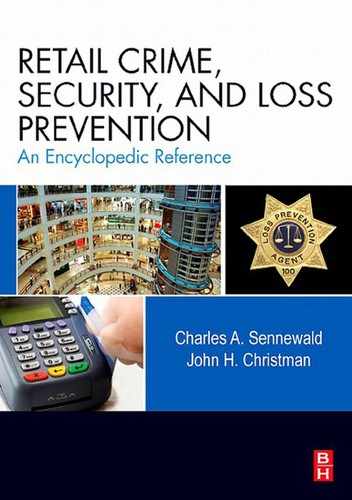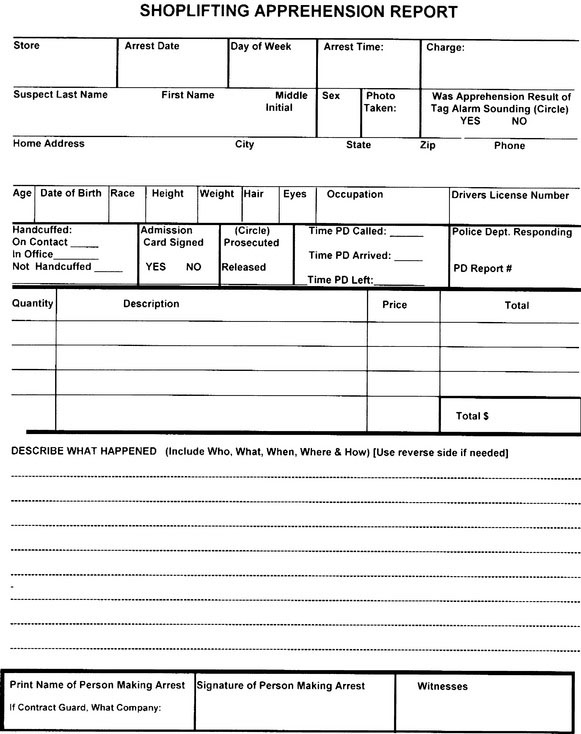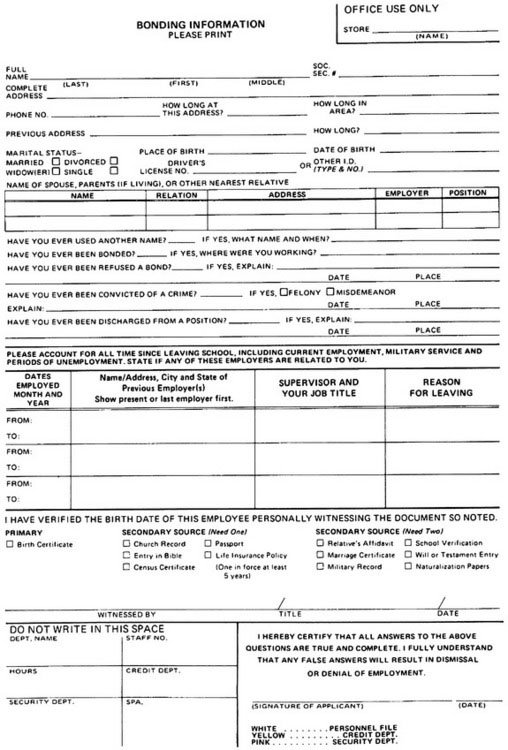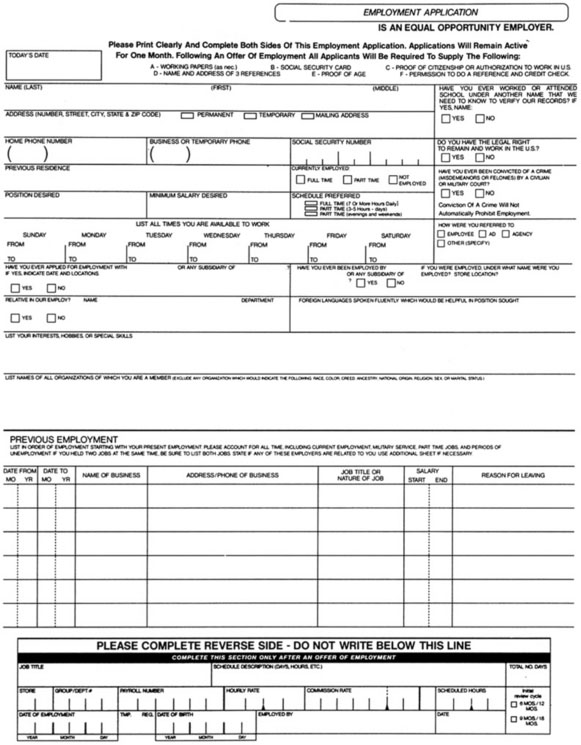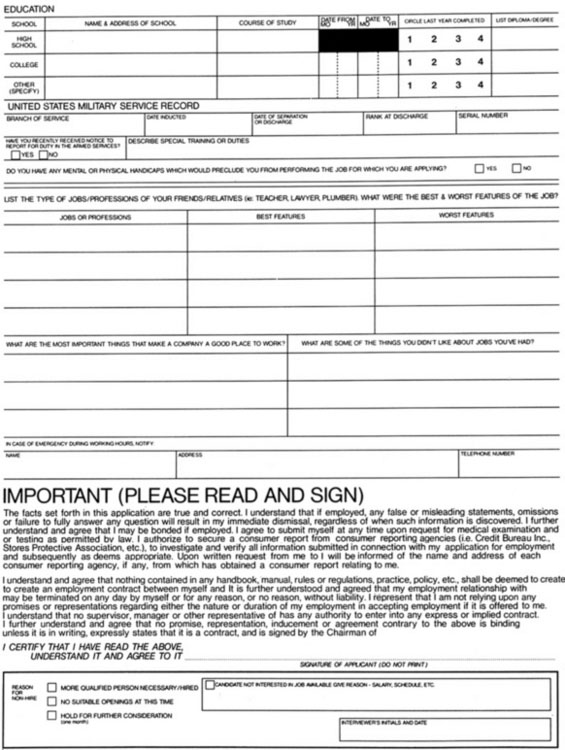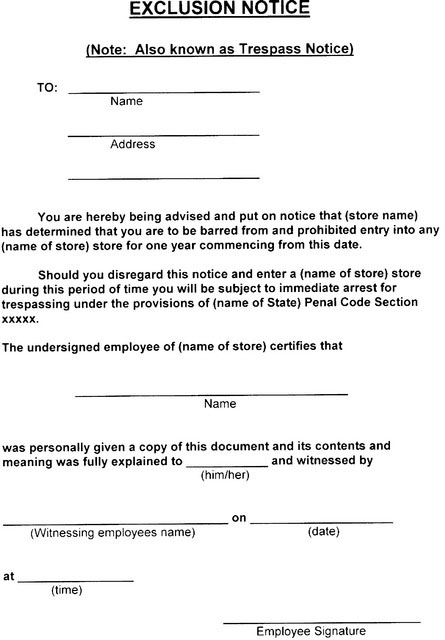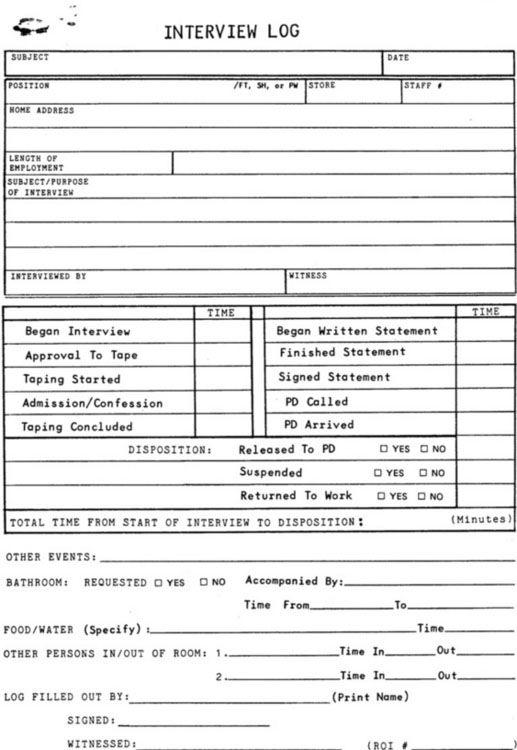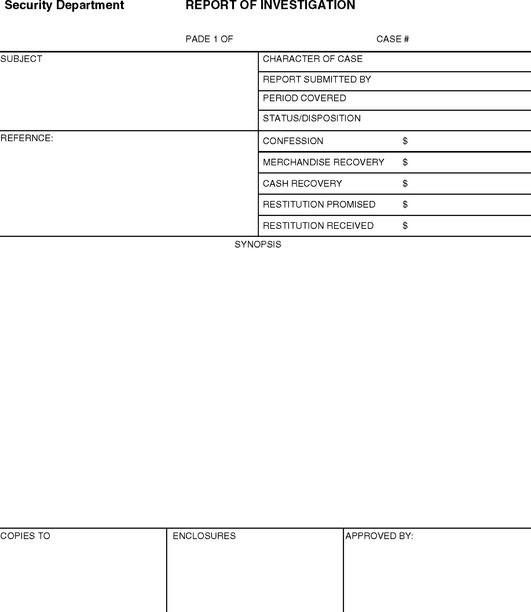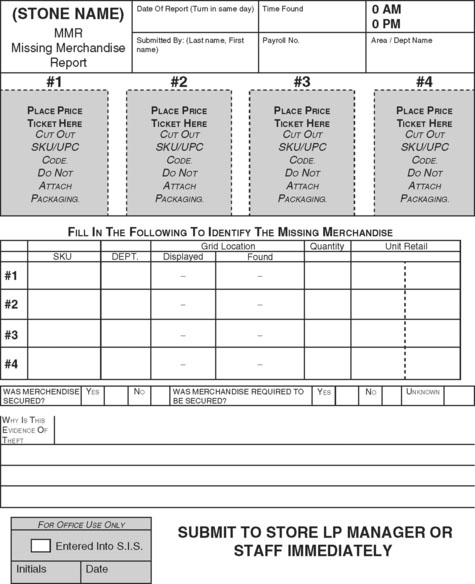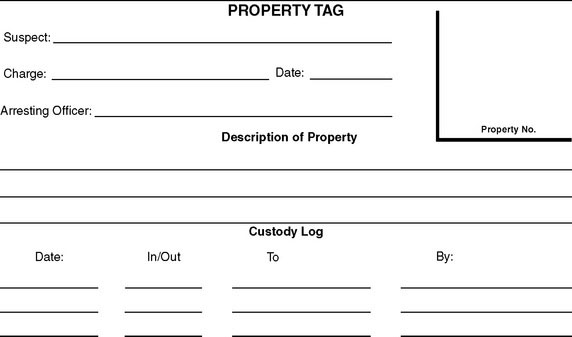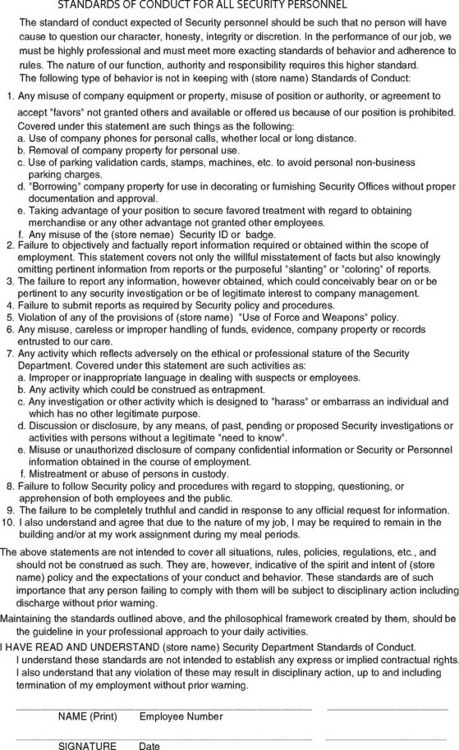F
Fences and Fencing
The word “fence” or “fencing” usually conjures up the image of the rather typical 7-foot chain-link fence with an angled top extension of barbed wire or razor ribbon, which extends the total height another foot, and that barrier commonly surrounds and defines the perimeter of a given property. Its function is clear and necessary, i.e., to keep unwanted people out or off the property or to keep people inside and on the property.
In the retail industry, this type of fence or various modifications thereof are commonly associated with distribution centers and warehouse complexes. These facilities should be so enclosed, and the security or loss prevention staff should ensure the integrity of the fence is intact. Breaches of integrity include
• Holes or cuts which would allow passage through the barrier
• Trees or other elevated objects or structures which would facilitate scaling the barrier
• Vegetation at the base of the fence which could obscure holes or openings as well as crawl areas, allowing penetration into the property by slipping under the fence
Frequent inspections will reveal these breaches, resulting in the problem’s correction or repair.
But there’s another kind of “fencing” in retail which isn’t widely known or used to advantage, and that’s the use of “chicken wire” fencing material, which can be productively used behind the scenes in dock and stock areas within the store itself.
There are three common applications:
1. To prevent “horizontal traveling” behind the selling floor
2. To protect small high-theft/high-shrinkage merchandise in stock areas
3. To discourage entry into areas requiring special protection, including such property or equipment as POS terminals held in reserve
Prevent “Horizontal Traveling” Behind the Selling Floor
Many stores are laid out with the center space of the store dedicated to the public display and sales of merchandise (selling floor), and the stock areas are behind the sales area. Picture if you will a square building with an outer perimeter wall and then a second interior perimeter wall.
That space between the two walls is where the stockrooms are located, as well as rest-rooms, break rooms, and offices. The large empty square in the center is the selling floor. This imaginary building’s exterior perimeter has one door in front (for the public), one door in the back for shipping and receiving, and two side doors for emergency exits.
The inner wall has numerous doors and openings, most of which lead into the stock area for the goods displayed in that area of the building. In a sporting goods store, the stock area for fishing rods and tackle is accessed through a door close to where that kind of merchandise is displayed and sold. Further down the store is the place where archery goods, bows and arrows, and targets are offered for sale, with reserve stock accessible through a door in that area. So-called horizontal travel is the condition in which a thief (employee or customer) can carry an item or goods from the fishing department and then enter the stock area of that department and come out in the archery department a good distance away with no merchandise in sight. The employee in the fishing department lost sight of the customer while his back was turned and that customer reappears elsewhere and no one is the wiser.
Inexpensive pinewood-framed gates of chicken wire erected between given stock areas, secured with padlocks, preclude this kind of behind-the-scenes movement and deny or impede employees from roaming through stock areas in which they have no business.
Prevent “Vertical Traveling”
In a multistory store, traditional behind-the-scene stairwells (often in corners of the store, which also serve as fire exits), up and down (vertical) travel is discouraged by fences (here, more typically chainlink instead of chicken wire because damaged chicken wire doesn’t bother the crook quietly fleeing downstairs to hit the street exit) and fence gates alarmed with audible alarms. Since, as mentioned, these stairwells are often fire exits, we must be sure that the fence gates permit emergency exit but not without a short (15-second) delay, permitted by fire codes, and audible notification of the breach. Not only do we want to restrict this kind of travel down to the street exit (unless an emergency, of course), we don’t want bad guys disappearing into stairwells and traveling up only to cross the store and descend on the other side. Preferably, doors leading from stairwells into the store cannot be opened from the stairwell side—only from the store’s interior, the result of which is that, once in the stairwell, a person can exit only onto the roof or onto the street or outside. If that strategy is adopted, signage on each door explaining this emergency exit and its consequences is required.
Protect Small High-Theft/High-Shrinkage Merchandise in Stock Areas
Inexpensive “cages” constructed of 1-inch pine board and chicken wire can be effectively used to control high-shrink items in stock rooms, merchandise which typically is held in reserve on open shelving. Clearly, this limits access and reduces theft by stockroom prowlers and employees. Chicken wire can easily be defeated or cut, but the protective power in such cages (and barriers) is the evidence of the entry or breach is so apparent that it serves as a good deterrent.
Discourage Entry into Areas Requiring Special Protection, Including Such Property or Equipment as POS Terminals Held in Reserve
Your authors have seen areas within stores which are indeed fenced off with regular cyclone fencing, and appropriately so. In cases in which extremely high value merchandise is caged, the “ceiling” of such a cage may also be covered with cyclone fencing, but typically such internal fencing doesn’t go to the ceiling, nor is it topped with barbed wire. And such protective configurations have been breached by employees. With the erection of but a 2-foot chicken wire “fence” on top of the cyclone fence, breaches can be averted because of the predictable tell-tale evidence of crushed or flattened chicken wire.
Scissors Gates
Scissors gates constitute a form of “fence” or barrier which has application in both exterior and interior situations. Small storefront retailers can pull this form of barricade across the front of their front windows and door to prevent entry or looting through windows that have been smashed in. These collapsible gates don’t guarantee total security; they are vulnerable to those burglars who use a vehicle to pull the gates off with a heavy chain. Some stores, depending on this configuration, opt to install the gates on the interior side of the windows, which precludes them, normally, from being ripped off by a vehicle. For example, in a fashion department store, a large single window in an alcove containing the men’s suit department had a series of window smashes and many expensive suites removed. An exterior scissors gate was considered objectionable in terms of its appearance. Instead, the store opted to install the gate on the inside, and when the store was open to the public, the gates were concealed behind attractive drapes.
Fire and Fire Prevention
For those stores fortunate enough to have a security or loss prevention department, their personnel will normally be the first responders to a fire and are usually given the responsibility for fire prevention. For smaller stores, these duties fall to either the owner, manager, or in some cases, whoever happens to be on duty. For these reasons, it is vital that all employees have some understanding and knowledge of fire prevention and the safe and correct response to an actual fire.
It can be reasonably said that a fire, regardless of how small it may be, is perhaps the most devastating event that can occur to a retailer. Why is a fire so devastating? The answer is the cause of all the ancillary things that accompany a fire. The retailer is concerned not only with items that may be destroyed or damaged by the actual blaze, but also t the resultant damage to merchandise from water and from smoke, in addition to the damage to the fixtures, displays, carpeting, walls, and structural or physical damage to the property itself. The damages just described do not even address the lost business from having to close the store for renovations and repairs.
For these and other reasons (an increase in insurance premiums, for example), fire prevention becomes an essential part of retail loss prevention. Additionally, for those fires that do occur from unpreventable causes, knowledge of ways to minimize fire damage also becomes important.
Since fire prevention is so important, it is helpful to know something about the technology of fire. Just what is fire?
Fire Technology
A. The intent of this section is to provide a basic working knowledge of the technology of fire, which will be required when outside help is not available. It is possible to be in a situation (e.g., in the case of either a major earthquake or riot) in which municipal fire protection would not be available, and it would be entirely up to the store to handle the firefighting either until it was extinguished or it posed no threat to personnel safety.
B. Fire results principally from the combination of combustible materials with oxygen and the presence of heat. In order for a successful fire to develop, it is necessary that the chemical union resulting be the combination of circumstances whereby heat, fuel, and oxygen are united under conditions which produce combustion.
C. Fire-suppression methods commonly employ a combination of removal of oxygen and lowering of ignition temperature. Removal of fuel seldom is practical or even feasible.
D. The control of availability of oxygen is of primary importance as an initial action in fire suppression. Closing all windows and doors and isolating the fire to a confined space are of primary importance. A normal fire can consume the oxygen in a confined space, and oxidation or burning will cease.
E. The ignition temperatures of ordinary combustible materials lie between 400 and 1,100 degrees Fahrenheit.
F. Most combustible materials such as wood and textiles are broken down by heat to form combustible gases. The flame is the burning gas, and for the most part, the actual combustion is that of the gases produced rather than the wood or textile items. Gases are often produced in fires, under conditions in which they do not completely burn but accumulate in the building and flash or explode later when there is an additional supply of air with the normal quantity of oxygen supplied to the fire area.
G. Heat is transferred from one material to another by one or more of three methods: (1) conduction, (2) radiation, or (3) convection.
Fire Prevention
“An ounce of prevention is worth a pound of cure” is certainly an axiom worth following when it comes to fire prevention.
What are some steps that should be routinely taken to prevent avoidable fires? We strongly suggest that the following items be on a checklist for periodic (at least monthly) inspection:
• Check the overuse or improper use of extension cords, paying particular attention to the gauge of the wire to be certain it is adequate for the load. Inspect for worn insulation. Never place cords on nails or under carpeting. All electrical items should be UL approved.
• Watch for hot (temperature) lights, particularly if near inflammable materials.
• Dispose of all trash on a regular basis; use proper containers.
• Avoid “do it yourself” electrical repairs.
• Inspect all fire extinguishers at least annually for condition and currency (proper charge levels).
• Avoid too many appliances, lights, etc. on a circuit or extension cord.
• Avoid blocking sprinkler heads with stock.
• Clearly mark locations of fire extinguishers and hoses.
• Clearly sign emergency exits.
• Inspect monthly to assure that the sprinkler system control valve is fully open. Some authorities recommend these valves be chained and locked in the open position; if this is done, hang a small sign on the chain reading “OPEN.” This is fine as long as a key is quickly available to enable the valve to be closed when necessary.
• Never block exit corridors, fire exits, or fire equipment.
• Paints, solvents, spray adhesives, etc., should be tightly sealed or capped while not in use and stored in proper containers. Almost every type of aerosol dispenser is extremely flammable and should be kept away from heat, sparks, and flames.
In the Event of a Fire
Upon detecting a fire or odor of smoke, or receiving a report of the same:
A. IT IS ABSOLUTELY ESSENTIAL THAT ALL FIRES, HOWEVER SMALL, MUST BE IMMEDIATELY REPORTED TO THE FIRE DEPARTMENT. THERE ARE NO EXCEPTIONS TO THIS RULE.
B. Attempt to put out the fire if it can be safely done. Never try to fight electrical fires.
If store is located in a mall, notify the mall office.
If so equipped, make the following announcement over the public address system: “May I have your attention, please. Because of municipal codes, we are required at this time to conduct a fire drill. Your cooperation is required. Please proceed quickly, but calmly, to the nearest customer exit. The store will resume normal operations in a few minutes at the end of the drill.”
If the store has elevators, a paramount priority should be evacuating individuals trapped in elevators.
Classification of Fires and How to Extinguish Them
A. All types of fuels have been classified into four general categories or fire classes to determine the best method of extinguishment.
B. This classification system is the principal guide in selecting the portable fire extinguisher to be used on a fire.
Portable and Manual Fire-Suppression Equipment
A. General Information
1. At their start, most fires are relatively small and can be easily handled. Because of this, it is essential that you be completely familiar with the locations and use of portable fire extinguishers.
2. Fire is usually a chemical action between fuel and oxygen, producing light and heat. The ignition temperatures of different “fuels” or combustible materials vary, but once ignited, these fuels produce enough heat to keep the fire burning. By eliminating any one of the preceding factors, fire can be extinguished. This can be done as follows: heat, by cooling; oxygen, by smothering; and fuel, by removal.
B. General Procedure and Use of Extinguishers
1. Fire extinguishers are designed for small fires and therefore are used close to the burning material. The following general guidelines should be observed in utilizing fire extinguishers:
C. Choosing the Correct Extinguisher
1. To be effective, the correct extinguisher must be chosen as relating to specific fire conditions depending on the type of combustible involved.
2. The suitability of a particular extinguisher must be judged in the light of the situation under which it may be used. The variety of types and sizes available throughout the store should include seven or eight specific types:
D. Method of Operating Extinguishers
1. The method of operating the extinguisher is clearly outlined on the extinguisher label, but the potential extinguisher user should have a thorough knowledge of how to operate the extinguisher prior to any need to do so.
2. The common methods of operation are to invert the soda acid units, or to operate a lever in the case of the pressurized water units and the dry chemical units as well as the carbon dioxide units.
Handling Hose from Permanently Installed Fire Installation
1. There may be permanently installed fire hoses in several strategic locations.
2. These hoses consist of either a wall-mounted reel or a hose rack with folded hose. The hose size is 1½ inches in diameter.
3. It is essential that the entire rack or reel be unloaded before the hose is charged or filled with water.
Automatic Sprinkler System
A. Many buildings are equipped with automatic sprinkler systems, which in turn are supervised by automatic fire alarm systems.
B. The activation of a single automatic sprinkler head (or more) will not only provide a water spray over the fire but also will automatically trigger an alarm.
C. Sprinklers generally cover an area between 100 to 130 square feet. The normal discharge is in the vicinity of 30 gallons per minute per sprinkler head activated. With the exception of any penthouse, roof areas, and kitchen areas which are subject to higher temperatures, the normal sprinkler heads will activate at 165 degrees Fahrenheit. The following special conditions are likely to reduce sprinkler effectiveness:
D. You should have a thorough knowledge of the distribution of the sprinkler system in your building. This includes both the main risers as well as the system of lateral mains. An enunciator panel, if present, will indicate the area of operation of the sprinkler system. In addition, it is essential that the following supplies be maintained:
Some Cautions
A. It is essential that designated persons report to the scene where any sprinkler head has been activated either by fire or a malfunction, or a damaged sprinkler system, such as a sprinkler head being knocked off.
B. It is absolutely essential in the event of a fire that the sprinkler system be allowed to function until there is no question of the fire being out. Only an officer of a responding fire department should have the authority to shut off the sprinkler system. The valve should be left open until ordered to shut down by the commanding officer of the firefighting force responding from the municipality having jurisdiction. The system should remain shut down only long enough to replace the fused (open) sprinkler head.
C. Service and the water supply must always be restored immediately.
Controlling Water and Smoke
A. Personnel should know the location of sprinkler shutoff valves and be familiar with the operation of the store sprinkler system, including procedures for operating floor sectional shutoff valves.
B. If a sprinkler system exists, a supply of emergency sprinkler head stem flow plugs should be maintained for stemming the flow of water in an activated sprinkler head.
Salvage Operations: Recovery
Salvage operations include all measures after a fire or other emergency for the purposes of reducing loss from smoke, fire, or water, plus minimizing business interruption.
A. An important part of salvage is actually in prevention of property damage from water, whether it be from hose streams, automatic sprinklers, broken piping, or flooding from storms or sewer backup.
B. The water damage phase of salvage work involves protecting merchandise from contact with the water and removing the water from the premises with a minimum amount of damage.
C. In addition, salvage operations involve the protection of property from the effects of heat, smoke, and contaminants in the various gases generated as the byproduct of a fire. This is most effectively accomplished by removal of the smoke and gases in an efficient manner through the use of exhaust venting and directional exhausting as accomplished by portable fans. In some cases, air conditioning and exhaust fans may be reversed to clear an area.
D. It is important to use chemical deodorants promptly after the fire to minimize smoke odors.
E. Salvage also includes the protection of records and associated equipment essential in maintaining the business operation.
F. Salvage equipment on hand for use by the fire brigade should include sacks of sawdust for diking standing water and controlling surface water from an automatic sprinkler operation, low-cost disposable plastic covers normally in a size of 9 × 12 feet or larger, and adequate containers for removal of surface water, along with mops and squeegees.
G. There should be a supply of sprinkler wrenches, sprinkler heads, and sprinkler wedges.
Fitting Rooms and Their Control
Fitting rooms represent, because of the privacy they are intentionally designed to provide to the customer, a high-risk theft environment with a relatively low probability of theft detection potential. With this fact in mind, how can a merchant minimize fitting room thefts?
We begin by dealing with the fundamentals. Once we establish why customers feel more comfortable stealing from fitting rooms than elsewhere, we can then devise policies and procedures to make stealing from fitting rooms more uncomfortable and thus reduce the amount of theft occurring there.
Customers, quite naturally, feel a sense of privacy and anonymity in fitting rooms because these rooms are designed to provide that very privacy. If we can reduce the feeling of privacy for potential thieves in ways which do not create aversion in honest customers, we should be able to reduce the corresponding theft rate.
What is the most effective shoplifting deterrent? Good customer service, of course! Honest customers appreciate good service, while the potential thief hates it because it limits the opportunity to steal. Remember, in order to commit a theft, three things must coexist: the motive to steal, the means to steal, and the opportunity to steal. Good customer service (“that nice sales person is looking in on me again to offer help—how nice of her”) removes much of the opportunity to steal. While many means (e.g., CCTV, peek-holes, two-way mirrors) are illegal to use to monitor fitting rooms, the attentive knock on the fitting room door with an offer of assistance by a sales associate is not.
We do not want to tempt honest customers into a theft by almost inviting them to steal. Leaving merchandise from a previous user in a fitting room may tempt the next user to steal it, since that person was not seen taking it into the room and is not associated with those goods. Therefore, the frequent removal of merchandise left in fitting rooms (“clearing” fitting rooms) is a simple but effective way to reduce theft opportunities.
What else can be done to help deny the opportunity to steal from fitting rooms?
A very inexpensive technique is signing the fitting rooms or fitting room banks (see Figure F-1). Attractively designed signs stating that “this area is patrolled by sales and security for your safety” may do the job in a tasteful way. A more forceful sign used by some stores states “Shoplifting is a crime. We prosecute all shoplifters.” Every store must determine the bluntness bluntness (or subtleties) of any signs used.
Stores can also limit the number of garments allowed in fitting rooms at any one time. When stores limit the numbered of garments allowed, it is easier from associates to better observe what is being taken into the fitting room and, equally important, what is brought out.
Limiting the number of garments can be on the “honor system” by simply posting signs stating that there is an “x” garment limit on merchandise taken into fitting rooms at any one time. A more sure method of obtaining compliance is to have fitting room checkers (see following description) stationed at the entrance to the fitting room bank who hand the customer a colored and numbered disk indicating the number of garments taken into the fitting room. When this system is utilized, the store may determine to allow any reasonable number of garments into the fitting room. It is important, however, to provide a method for securing these disks when not in use and periodically checking to be certain none are missing. A stolen disk for two garments is literally a license to steal merchandise, if the customer was issued a disk for three or four items.
Fitting room checkers (women who are associated with the loss prevention department) are often utilized by larger stores. These stores maintain “banks” of fitting rooms (i.e., a number of fitting rooms accessed by a common hallway with a single entrance/exit to the hallway). The fitting room checker (FRC) is stationed at the entrance to the bank hallway, thus maintaining control of the use of the fitting room.
For smaller stores that may have only one or two isolated fitting rooms, we suggest some system for determining if the room is occupied. One simple way to accomplish this is to provide a motion detector or an old-fashioned “pressure mat” under the carpeting which, when the room is occupied and a customer is standing on the floor, closes an electrical circuit and either sounds a chime or illuminates a small red light above the fitting room entrance. Another strategy is to have the pressure mat activate the light which illuminates the room; hence, all rooms which are “dark” are unoccupied, and only those rooms in actual use are illuminated. This chime, light, or illuminated room or light not only signals the room is occupied (thus letting the occupier know that someone knows he or she is there), but also permits sales associates to both monitor the room and be in a position to offer customer service, as well as rehang merchandise brought back out and not purchased.
The design of fitting rooms can also either encourage or deter fitting room theft. While it is obvious that privacy to those using the room prevents viewing inside the room from public areas, that same level of privacy is not necessary if the room is within a fitting room bank whose access is restricted to only one sex. In such situations (i.e., within a fitting room bank), it is permissible in many jurisdictions to utilize so-called reverse louver fitting room doors, which permit FRCs to monitor the inside of the room from the hallway bank. Installing doors which have 12 to 18 inches of space between the bottom of the door and the floor and which extend only to a height of about 5½ to 6 feet above the floor also discourages theft. If hanging curtains or drapes are used to cover the entry, they should be approximately 4 inches short of the width of the fitting room’s entrance. This arrangement should never be used if the fitting room is accessed directly from the selling floor.
Finally, it is suggested that all cracks (between the walls and built-in seats, mirror edges, signs and sign holders, etc.) be caulked to prevent hiding torn-off price and manufacturers’ tickets in these areas. Seats with cushions should have the cushions permanently attached. There should be no wastebaskets in fitting rooms. Rooms should be periodically inspected for hidden tickets and/or places where such tickets could be hidden or disposed of, including light fixtures, loose edges of carpeting, and the even the narrow top ledge of the room dividers.
There is a widespread but mistaken belief that once a shoplifter enters a fitting room to steal, he or she is immune from detention, arrest, or prosecution. Nothing is further from the truth. While the detention of shoplifting suspects who have stolen while in a fitting room must be handled with care and caution, that does not mean they are “home free” and the store is unable to react. Many companies either prohibit or place stringent restrictions on detaining persons suspected of fitting room theft. We are of the opinion this is a flawed strategy, not well thought through, which only encourages theft.
The genesis of this mistaken belief and fitting room detention restrictions is that the industry’s generally acknowledged “six steps,” which are required before detaining a shoplifter, prevent detaining fitting room shoplifters. Specifically, Step 4 requires loss prevention to “[m]aintain an uninterrupted surveillance to ensure that the suspect doesn’t dispose of the merchandise.” The fact is that an uninterrupted surveillance is often broken after a loss prevention agent sees the customer pick up a red sweater and a blue sweater and enter a fitting room with both sweaters. If the fitting room does not have “reverse louvers” permitting a same-sex LP agent to observe, surveillance is lost while the customer is in the fitting room. The agent, however, keeps the fitting room under constant observation and subsequently observes the customer leaving the fitting room carrying only the red sweater. A quick check of the fitting room, while still maintaining surveillance of the customer, discloses the blue sweater is not there, and there is no physical way the customer could have disposed of the blue sweater while in the fitting room. Thus, the only logical conclusion any reasonable person can reach is that the customer (now a suspect) must still be in possession of that blue sweater. The agent then continues an uninterrupted surveillance of the suspect until she is observed leaving the store without having paid for the blue sweater. Can the agent now detain the suspect? We maintain that even though the customer could not be seen while in the fitting room, the room and its door was, and surveillance continued once she came out of the room and continued until she left the store; accordingly a detention is permissible under what we have identified as the “constructive unbroken chain of surveillance.” This concept is discussed in depth in Shoplifting: Managing the Problem, published by ASIS International, 2006.
Bear in mind the authors are the pioneers of the Six-Step Rule, and the steps were created to reduce the possibility of error. The six steps are not the law of the land, but are industry standards and are recommended as an internal strategy to reduce mistakes. The overriding rule or law is probable cause, the law of the land, which would support the notion if a lady enters a small room with no one else in the room, and when she enters she’s carrying in full view a blue sweater, and she exits shortly thereafter without the blue sweater, and the sweater is not in the room (and the sweater was not thrown over the partition or under the partition into another room), the sweater did not evaporate into thin air! It’s most probable the lady has the sweater hidden on her person or out of sight among her affects. And consequently, the merchant has every right to investigate, and, we maintain, probable cause to detain for that purpose.
Remember, most merchants’ detention statutes require “probable cause” to detain; we maintain that under the limited scenario of a missing identifiable item, with no chance of prior disposal, the fitting room situation described provides such probable cause.
While we repeat that fitting room thefts require deft handling and caution, they do not require that common sense be surrendered and such thefts be done with impunity.
Obviously, aside from this or a like kind of exception, the proper course of action would be to start the six-step process all over again.
Forms
Set out in Figures F-2 through F-15 are generic forms used frequently in the security/loss prevention discipline.
Note While this work is copyrighted, we urge you to avail yourself of these forms and use them as guides for the development of forms meeting your specific needs.
Fraudulent Outsourcing and Invoicing
In the 21st century, outsourcing functions traditionally performed by company employees has become a sign of the times in businesses of all types, retailing being no exception.
Our concern, however, is the fraudulent outsourcing of functions and/or the fraudulent invoicing for allegedly outsourced functions or services.
Two actual cases of fraudulent “outsourcing” will serve to demonstrate the vulnerabilities involved.
Case # 1: The display department of a major retailer received, over a period of time, invoices for services rendered, including the delivery of common items used by in-house display departments such as paints, mannequins, paper items, etc., all from a local company submitted on very authentic-looking stationery. The bills were submitted to a first-line supervisor who was the person responsible for authenticating the receipt of the supplies and legitimacy of the invoice. Since the invoices were all for relatively small amounts (nothing over $1,000), they did not attract senior-level scrutiny. At some point, a new employee in the department questioned an invoice and reported his concerns to a senior display executive. This executive reported the matter to the company’s security department, which initiated an investigation. The investigation disclosed that the “company” that was invoicing the department did not exist; there was no business license in that name, and the address on the invoices was a residential address. Further investigation disclosed two employees, including the first-line supervisor who had been initially approving the invoices for payment, were submitting invoices for goods and services never received. The loss to the company was in the several thousands of dollars; the employees responsible for the fraudulent billing were terminated and criminally prosecuted.
The lesson learned from this case is that all vendors (except for nationally recognized companies) should be vetted to provide assurances of legitimacy and ownership, including, but not limited to, a legitimate business address, a valid business license, references, and periodic audits verifying the existence of the goods and services being invoiced.
Case # 2: A major national cosmetics vendor required that its selling area be defined by a wooden display which met design specifications. A retailer selling its products assigned an employee to seek out and obtain estimates for the fabrication of this design. Several estimates were submitted, and the contract for fabrication was given to the bidder whose sample work met the acceptance of both the company and the vendor. What was unknown was that the chosen “bidder” was, in fact, a carpenter employed by the store who, by conspiring with a display department employee, won the bid on the wooden displays and then built them in his garage at night and on weekends. Eventually, the cosmetic line became extremely popular and was expanded into many other stores in the chain. The carpenter could not keep up with required production needs, which resulted in the retailers seeking other sources for the display. This resulted in the submission of quotes which were about one-third the cost of what was being paid to the off-duty employee carpenter. An investigation discovered the ruse, and the errant carpenter was fired; attempts to recover the overcharges for the displays were unsuccessful, since the retailer had accepted the bid which formed the basis for a valid contract.
The lesson to be learned from this case is the same as that from case #1: know whom you are dealing with and have all estimates and bids arrive through the mail direct from the originator.
Important note: A P.O. box address is not an acceptable address for a supplier or vendor. Such addresses cannot be verified. An actual street number and name must be required and subject to drive-by validation, should that be deemed necessary. We recommend an annual inspection of the “vendor’s wheel” or printout of the electronic list of vendors and suppliers to ensure complete addresses are on file, and an investigation into any which are deemed questionable. Invoices and/or envelopes which are rubber-stamped with the company name and address should receive extra scrutiny.
Fraudulent Refunds
When Aaron Montgomery Ward began using the phrase “Satisfaction Guaranteed Or Your Money Back” in 1875, the customer refund was born. Stores allowed customers to return merchandise for any reason or no reason, and receive a full refund of the purchase price. Almost immediately afterward, the fraudulent refund appeared. Retail stores, in their effort to provide customer service, opened a very large door which dishonest individuals were more than happy to enter. Refund fraud has been perpetrated by everyone from housewives to an aide to the President of the United States.
Refund fraud is a very appealing alternative to traditional shoplifting, as there is normally no need to leave the store. The basic concept of the fraudulent refund is this: Merchandise is represented as being purchased, either by the refunder or received as a gift, and is returned in accordance with the store’s refund policy for valuable consideration (i.e., money, store credit, etc.). Fraudulent refunds can be committed by one person who returns many items or by large organized crime rings, ultimately costing stores and subsequently consumers millions of dollars through increased prices. The fraudulent refund can be more damaging to a store’s finances than other theft methods. If the store’s accounting methods book returned items back into the inventory, a fraudulent refund can cause a double loss. First, the store loses the monetary value of the item when it is paid out to the fraudster (since the payment to the refunder effectively has the store purchasing the item at full retail), which adversely affects the store’s gross margin, and thus its profits. Second, the store’s inventory is now artificially inflated due to an item already in the inventory being booked a second time into the inventory. Thus, when the store takes an inventory, it will show shrinkage in the item that was fraudulent refunded, because the book inventory was artificially increased by the refunded item being booked into inventory.
Refund fraud is a multimillion dollar issue in the United States. It has become so much an issue in retail that few stores today have unqualified “No Questions Asked” return policies, but have begun taking a harder stance to ensure that refunds are legitimate and that policies are not violated. Despite the increase in more restrictive return policies to establish proof of purchase as well as the use of technology, refund fraud continues to grow, mostly due to the advent of the merchandise gift card.
The basic fraudulent refund is a simple activity. A fraudster enters a store, picks up a piece of merchandise, and then takes it to an employee and represents that he has purchased the item but now would like to return it. The employee processes the refund and gives the fraudster cash back for the item. Thus, the fraudster now has cash, and the store has purchased back the merchandise at full retail, creating a loss of gross margin.
More elaborate refund schemes can include purchasing an item in order to receive a receipt. Then the refunder selects an identical item to return using the receipt as proof of purchase. If the receipt is not either retained by the store or marked to show the item returned, the original item may also be returned with the original receipt. Even more elaborate refund schemes may involve the copying or computer printing of phony receipts for items to be stolen and returned, and the use of fraudulent refunds to increase open to buy on credit or gift cards. Unless valid original receipts are required or other methods of verifying the original sale price are in place, items purchased on sale may later be returned for full price.
In addition, dishonest employees also commonly use refund fraud, although the methodology is a bit different. Often in employee refund fraud, the employee will process refunds using only SKU information instead of actually selecting items. The employee will ring the refund as cash, as a credit to a personal credit card, or as a credit to a store gift card. No merchandise is present for these transactions, and there is no customer present, so the chances of spotting an employee processing a fraudulent transaction in this fashion are increased.
There are numerous methods in use today to deter fraudulent refunds. One of the biggest misconceptions involving refunds is that a store must issue a refund for merchandise purchased. In fact, a store is under no legal requirement to refund merchandise. Stores have chosen to offer refunds as a form of customer service but have the right to refuse to process refunds. This is one of the keys in combating refund fraud. Stores have begun to take a much stricter approach in dealing with refunds. Instead of offering a “no questions asked” approach, stores are enforcing policies requiring receipts, proper identification, and method of payment (the latter to combat the bad check or credit card which has not yet been cleared or fully processed).
Previous methods to validate the legitimacy of refunds consisted of sending post cards to the name and address shown on the refund document in the guise of a survey on customer service. In actuality, these mailings are used to determine if addresses were correct, or if people responded that they never returned an item, or, more commonly, the letter is returned by the post office marked “address unknown” or similar marking indicating a phony address.
Historical data on returns by employees have also been maintained to help identify employees who have a large percentage of no-receipt refunds, cash refunds, or refunds to the same credit card.
Another method historically used was the issuance of a check instead of cash for non-receipted refunds. In this method, a customer refunding an item without a receipt would not receive a refund at the time of return. Instead, the customer’s name and address would be taken, after which the customer was advised a check would be mailed to him or her for the purchase amount within 30 days. This deterred any fraudsters from obtaining immediate cash from their fraudulent refunds, but more importantly, if the refunder provided a fictitious name or address when the form was being completed, the check would be returned to the store as undeliverable. This also provided a means whereby such phony addresses could be tracked.
Stores have also begun using other technology to combat refund fraud. Some examples include several department store chains which attach individual bar code stickers to items that identify that specific item back to a sales transaction. An item returned without the bar code is denied a refund. Other retailers are maintaining records of sales activity in their computerized system and can look up an individual purchase by use of the customer’s credit card number, thus enabling that customer to receive instant refunds. Customers who do not have a receipt or whose sale cannot be identified receive either a mailed check or a credit good only for merchandise. Still other retailers are placing bar codes on the customer receipt for transaction history purposes. Thus, an item purchased can be returned only one time.
Stores are maintaining databases of frequent returners. Those people are identified in the system by means of their identification and can be denied a refund if their refund activity meets a predetermined level. The important component of this is to ensure that proper identification is obtained each time a refund occurs.
Lastly, stores have begun giving out merchandise credit cards in lieu of cash on nonreceipted refunds. While this method has had some success, the unanticipated consequence of it has been a large increase in the sale of merchandise credit cards over the Internet, on websites like eBay or Craigslist. Fraudsters will sell the card for a lesser amount of cash and never need to return to the store to use the card.
Refund fraud will continue to be a problem for any retail company that accepts merchandise back. However, proper policies, the enforcement of those policies, and technological advances can help lower the impact that refund fraud has on a business.
Author’s Note: If fraudulent refunds are suspected, some areas which may be illuminating and should be examined are
• Associate accounts with large number of No Receipt Returns (NRRs)
• Third-party accounts with large numbers of No Receipt Returns
• Associates making large numbers of No Receipt Returns
• Third-party accounts with high dollar amounts of No Receipt Returns
• Associate accounts with high dollar amounts of No receipt Returns
Additionally, whatever policies are created to deal with refunds, they must be universally applied to similar situations so as to avoid charges of discrimination.
